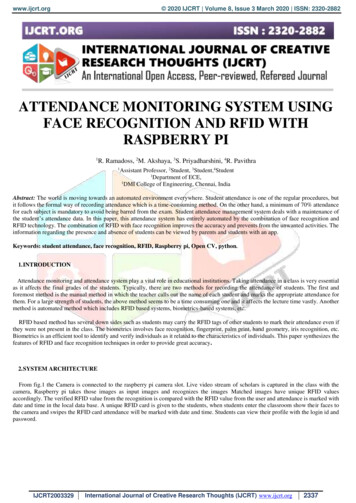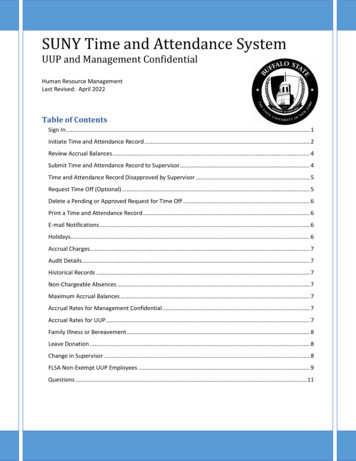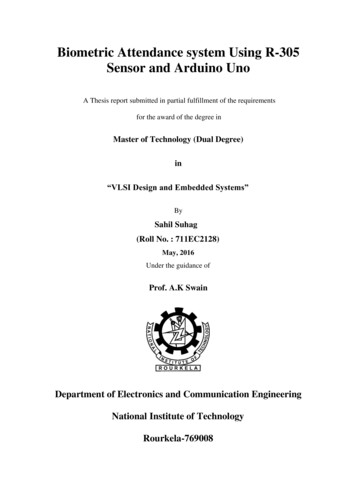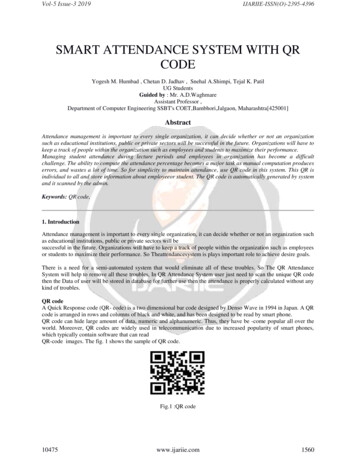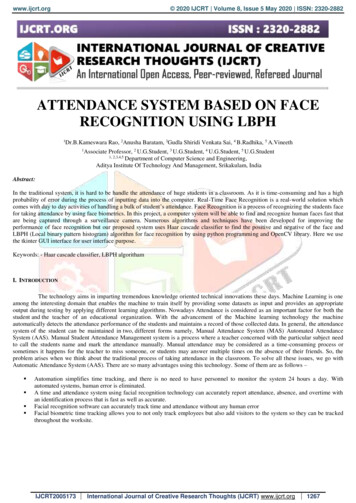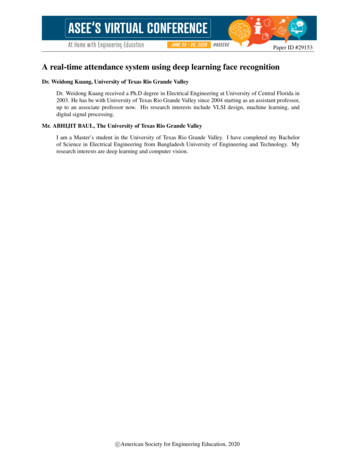
Transcription
Paper ID #29153A real-time attendance system using deep learning face recognitionDr. Weidong Kuang, University of Texas Rio Grande ValleyDr. Weidong Kuang received a Ph.D degree in Electrical Engineering at University of Central Florida in2003. He has be with University of Texas Rio Grande Valley since 2004 starting as an assistant professor,up to an associate professor now. His research interests include VLSI design, machine learning, anddigital signal processing.Mr. ABHIJIT BAUL, The University of Texas Rio Grande ValleyI am a Master’s student in the University of Texas Rio Grande Valley. I have completed my Bachelorof Science in Electrical Engineering from Bangladesh University of Engineering and Technology. Myresearch interests are deep learning and computer vision.c American Society for Engineering Education, 2020
A Real-Time Attendance System Using Deep Learning Face RecognitionWeidong Kuang, and Abhijit Baul, University of Texas Rio Grande ValleyAbstractAttendance check plays an important role in classroom management. Checking attendance bycalling names or passing around a sign-in sheet is time-consuming, and especially the latter is opento easy fraud. This paper presents the detailed implementation of a real-time attendance checksystem based on face recognition and its results. To recognize a student’s face, the system mustfirst take and save a picture of the student as a reference in a database. During the attendancecheck, the web camera takes face pictures for a student to be recognized, and then the computerautomatically detects the face and identifies a student name who most likely matches the pictures,and finally an excel file will be updated for attendance record based on the face recognition results.In the system, a pre-trained Haar Cascade model is used to detect faces from web camera video.A FaceNet, which has been trained by minimizing the triplet loss, is used to generate a 128dimensional encoding for a face image. The similarity between the encodings of two face imagesdetermines whether the two face images coming from the same students. The system has been usedfor a class, and the results are very satisfactory. A survey has been conducted to investigate thepros and cons of the attendance system on college education management.I.IntroductionAttendance plays a pivotal role in academic performance of students in schools and colleges.The consistent absence from class increases the risk of failure and early dropout. Attendancecheck is an efficient way to improve the attendance rate of a student in a class. The traditionalmethods include calling names or signing on papers, which is highly time-consuming andinsecure.To solve the issues associated with traditional attendance check methods, different types ofautomated attendance systems have been developed using different technologies. In thefingerprint-based attendance system [1], a portable fingerprint device is required to collect andrecognize students’ fingerprints to mark their attendances. In the RFID-based attendance system[2], students need to present their RFID cards to an ID card reader to record their presences. Inthe Iris-based attendance system [3], a camera scans the Iris of students, which will be used tomatch the Iris database of students, and to update the attendance of students. Recently, facerecognition based attendance systems are getting more attentions [4] [5] [6].In this paper, we proposed and implemented an attendance system based on face recognitionusing pre-trained deep neural networks. A survey from students in an implemented class hasbeen conducted to investigate the pedagogical impacts and potential problems of the system. Thepaper is organized as follows. The technical details of the attendance system are described inSection II. The experimental results are summarized in Section III. Section IV concludes thework.
II.The Proposed Attendance System2.1 Overview of ArchitectureThe proposed attendance system consists of four components: web camera face capture,student image database, face recognition, and attendance record update, as shown in Fig.1. Thesystem has been implemented in a laptop computer with a built-in web camera. Let’s consider atask of checking attendance for a class. To prepare for attendance check, all students in the classare required to take pictures (10 pictures in our project for averaging) through the built-in webcamera. These pictures are used to generate the student face database as a reference for real-timeface recognition. To check the attendance of a student for the class, the computer takes facepictures of the student through the real-time video stream and employs deep learning neuralnetworks to predict whether the student matches anyone in the database, and (if yes) furtheridentifies the name of the student. The result of this face recognition will be used to update theattendance record in the format of an excel file.Fig.1 Architecture of the proposed attendance system2.2 Face DetectionSince our identity recognition is based on a person’s face only, it is desirable to save the facepart as the image while excluding other parts of a person’s body or background. Thus, a facedetection technique is required to automatically detect the area of the face so that an image withalmost only face can be cropped and saved for later face recognition.Object Detection using Haar feature-based cascade classifiers is an effective object detectionmethod proposed by Paul Viola and Michael Jones in [7]. It is a machine learning basedapproach where a cascade function is trained from a lot of positive and negative images. We useHaar Cascade classifier to detect faces in an image. The detected face portion will be resized to a96x96 image (jpg). The resized image is either saved for database, or processed by a real timeface recognition system, which will be discussed in the following sections. The basics of facedetection using Haar Cascades can be found at [8]. Fig.2 shows the web camera screen with adetected face frame and saved face image (96x96 pixels).
(a)(b)Fig.2 Fact detection: (a) video screen with a green rectangle identifying a detected face;(b) cropped face image for database or face recognition.2.3 Face RecognitionAfter the face detection, we can assume that the images either for database or for recognitionare face-concentrated and resized to 96x96 pixels (e.g. Fig.2(b)). The algorithm of facerecognition is illustrated in Fig.3.The core component of the algorithm is the deep neural network, called FaceNet [9] [10],that directly learns a mapping from face images to a compact Euclidean space where distancesdirectly correspond to a measure of face similarity. Specifically, the FaceNet generates a 128dimensional encoding (i.e. a 128-element vector) from an image in such a way that: 1) Theencodings of two images of the same person are quite close to each other, and 2) the encodings of twoimages of different persons are far away from each other. Thus, the Euclidean distance between two suchencodings is used to determine whether the two face images came from the same person or not. Sincetraining this FaceNet requires a huge amount of data and computation, we directly load the previouslytrained model, called inception blocks v2 [11]. The number of parameters of the resulting model is3,743,280.In the database, there is a 128-dimensional encoding for each student in the class. To reducevariations, we took 10 face images for one student, and generated the corresponding 10 encodings, andsaved the average of the 10 encodings as the encoding for the student in the database. For each student,his/her name and an encoding are stored in the database, as a dictionary object with the name as the keyand the encoding as the content in Python.During attendance check, students are required to show their faces at the front of the web camera oneat a time. For one student, the program will automatically capture a face image and generate thecorresponding 128-dimensional encoding by the same FaceNet. Then a search algorithm is performed tofind an encoding in the database that has smallest distance from this real-time face image encoding, andthe associated student name. If the smallest distance is less than a pre-defined threshold (e.g. 0.6), thestudent has been recognized; otherwise, the student is assumed as “not be in the database”. Of course, theselection of the threshold will affect the recognition accuracy.To improve the accuracy of face recognition, the program captures multiple face images for onestudent in real time, and independently recognizes each face image, and generates the result based onthese multiple recognitions. For example, in our implementation, the program took 10 face images,followed by independent face recognitions. If among the 10 recognitions, 5 of them are recognized as the
same person, a recognition is assumed to be successful. Of course, the strategy – “5 out of 10” – isadjustable to achieve a better accuracy.Fig.3 Flow chart for face recognition2.4 Attendance MarkingThe attendances for all students in the class are marked in an excel file, e.g. cmpe3403A.xlsx.The initial file of the excel file is created by filling the first column with student names. Anexample is shown in Fig.5. Each column (except the first column) is used for attendance recordof one class meeting. If a student has been recognized more than 5 times out of 10 trials, theexact numbers of recognitions will be recorded in a corresponding cell that is associated with thestudent (row) and the date of the class (column). Thus, any student, who has a number (morethan 5) recorded, is considered as attending the class, while a student without a number recordedwill be considered as absence.In case of a failure of face recognition for a student, i.e. the student is recognized as anotherstudent in the class, or the student cannot be recognized as any student in the class, the studentshould notice the instructor the situation for a manual attendance check in the excel file.III.Results of ExperimentsThe attendance system has been implemented in a Lenovo laptop computer with thefollowing specifications: Intel core i5-7200U CPU @2.50GHz, RAM 8.00GB, Windows 10Pro. The system consists of three programs developed in Python 3. The first program captures 10
face pictures for each student in the class. The second one compiles FaceNet model and loadsparameters. The third one generates the database based on the pictures captured by the firstprogram, recognizes the face at the real-time web camera, and updates the attendance record inthe excel file. Thus, all visible results are delivered by the third program.Fig.4 is a screenshot that shows the result of a face recognition. The information of the resultincludes the frame identifying the location of the detected face, the recognized name (Will) at theup left corner of the frame, and the corresponding distance (0.4891317) to Will’s face encodingin the database. This distance gives a confidence on how surely the person is “Will”: the smallerit is, the more likely he/she is “Will”. The bigger word “Will” at the top center is the resultbased on the 10 consecutive recognitions. Fig.5 shows a portion of attendance record in an excelfile created by the attendance system. In Fig.5, the first column is for students’ names and thesecond is the attendance record. The number for a student is the number of recognitions among10 trials. A blank for a student means that either the student did not check the attendance, or thenumber of recognitions is less than 5 (i.e. face recognition failed). In case of the failure ofrecognition, the student needs to inform the instructor for a manual attendance marking.The test results in one class with 28 students showed that the accuracy of face recognition isabout 95%. However, the attendance system is sensitive to the changes of lightening and thedistance between face and camera. Dramatical change of these conditions can significantlyreduce the accuracy.Fig.4 Face recognition windowFig.5 Example of attendance markingTo evaluate the pedagogical benefits or concerns of the attendance system, we conducted asurvey on 21 students. On each survey there are 12 statements as follows:1)2)3)4)Using this system was enjoyable.This system is more efficient than attendance check by calling names.This system is more efficient than attendance check by sign-sheet.This system is more efficient than attendance check by doing quiz.
5) This system makes the attendance check easier for the instructor.6) This a room for the improvement of this system.7) This system should be used in other classes.8) I don’t like this system because I have a concern on my privacy.9) This system is suitable for all people including disabled (deaf).10) This system exposed me to a real AI project.11) This system inspires me to learn machine learning in the future.12) If I were the instructor in college, I would use the face recognition for attendance.For each statement, there are the following five options for students to select: strongly agree agree do not know disagree strongly disagreeTo quantize the overall opinions of students on each statement, we assign point numbers 2, 1,0, -1, -2 for the above five options, respectively. The total point of a statement is the weightedsum of the selected options. The larger the point, the more strongly the students agree. Anegative point shows disagree. For example, the first statement received 9 strongly agree, 11agree, and 1 do not know. Thus, the point of the first statement is 29. The result of survey isvisualized in Fig.6. The survey confirms the benefits of the attendance system such as efficiencyand convenience. As a demo, the attendance system exposed the AI technology to students. Thesurvey also shows that some students have privacy concerns and that the system could beimproved further.Fig. 6 A survey on the attendance systemIV.ConclusionAn attendance system has been implemented in a laptop computer using face recognition.The system was applied in a class for attendance checking. The accuracy of face recognition fora class of 28 students is about 95% if a consistently similar condition (e.g. light, face distanceand face expression) for image capture is maintained. The survey from students shows that thesystem is effective and efficient, and accepted by students.However, a few aspects for improvement can be pursued in the future work. First, the currentsystem consists of three Python programs (or files), and the operation of the system requires
some command line inputs. It would be more convenient for a user (e.g. instructor) to use thesystem if the system could be integrated into a single application file with a Graphic UserInterface (GUI). Second, we will update the system for a more robust face recognition if acorresponding algorithm is available. Third, based on the survey, some students have a privacyconcern on face recognition. It is important to address this concern.References[1] B.K. Mohamed and C. Raghu, “Fingerprint attendance system for classroom needs,” IndiaConference (INDICON), Annual IEEE, 2012, pp. 433-438.[2] S. N. Shah and A. Abuzneid, “IoT based smart attendance system (SAS) using RFID,” IEEELong Island Systems, Applications and Technology Conference (LISAT), 2019.[3] A. Khatun, A.K.M.Fazlul Haque, S. Ahmed, and M. M. Rahman, “Design andimplementation of Iris recognition based attendance management system,” 2nd Int’l Conf. onElectrical Engineering and Information & communication Technology (ICEEICT) 2015,Bangladesh.[4] S.Sawhney, K.Kacker, S. Jain, S. N.Singh, and R.Garg, “Real-time smart attendance systemusing face recognition techniques,”, 9th Int’l Conf. on Cloud Computing, Data Science &Engineering, 2019, pp. 522-525.[5] S.Sveleba, I. Katerynchuk, I.Karpa, I.Kunyo, S.Ugryn, and V.Ugryn, “The real time facerecognition,” 3rd Int’l Conf. on Advanced Information and Communication Technologies, 2019,pp.294-297.[6] R.Nandhini, N. Duraimurugan, and S.P.Chokkalingam, “Face recognition based attendancesystem,” Int’l Journal of Engineering and Advanced Technology (IJEAT), Vol-8, Issue-3S,February 2019, pp.574-577.[7] P. Viola, and M. Jones, “Rapid object detection using a boosted cascade of simple features”,Proceedings of the 2001 IEEE Computer Society Conference on Computer Vision and PatternRecognition. CVPR 2001.[8] https://docs.opencv.org/3.3.0/d7/d8b/tutorial py face detection.html .[9] F. Schroff, D. Kalenichenko, and J. Philbin, “FaceNet: A Unified Embedding for FaceRecognition and Clustering,”, Proceedings of the 2015 IEEE computer Society Conference onComputer Vision and Pattern Recognition, CVPR 2015, also available athttps://arxiv.org/pdf/1503.03832.pdf[10] C. Szegedy, W. Liu, Y. Jia, P. Sermanet, S. Reed, D. Anguelov, D. Erhan, V. Vanhoucke,and A. Rabinovich, “Going deeper with convolutions,” Proceedings of the 2015 IEEE computerSociety Conference on Computer Vision and Pattern Recognition, CVPR 2015, also available at:https://arxiv.org/pdf/1409.4842.pdf[11] n
recognition based attendance systems are getting more attentions [4] [5] [6]. In this paper, we proposed and implemented an attendance system based on face recognition using pre-trained deep neural networks. A survey from students in an implemented class has been conducted to investigate the pedagogical impacts and potential problems of the system.

